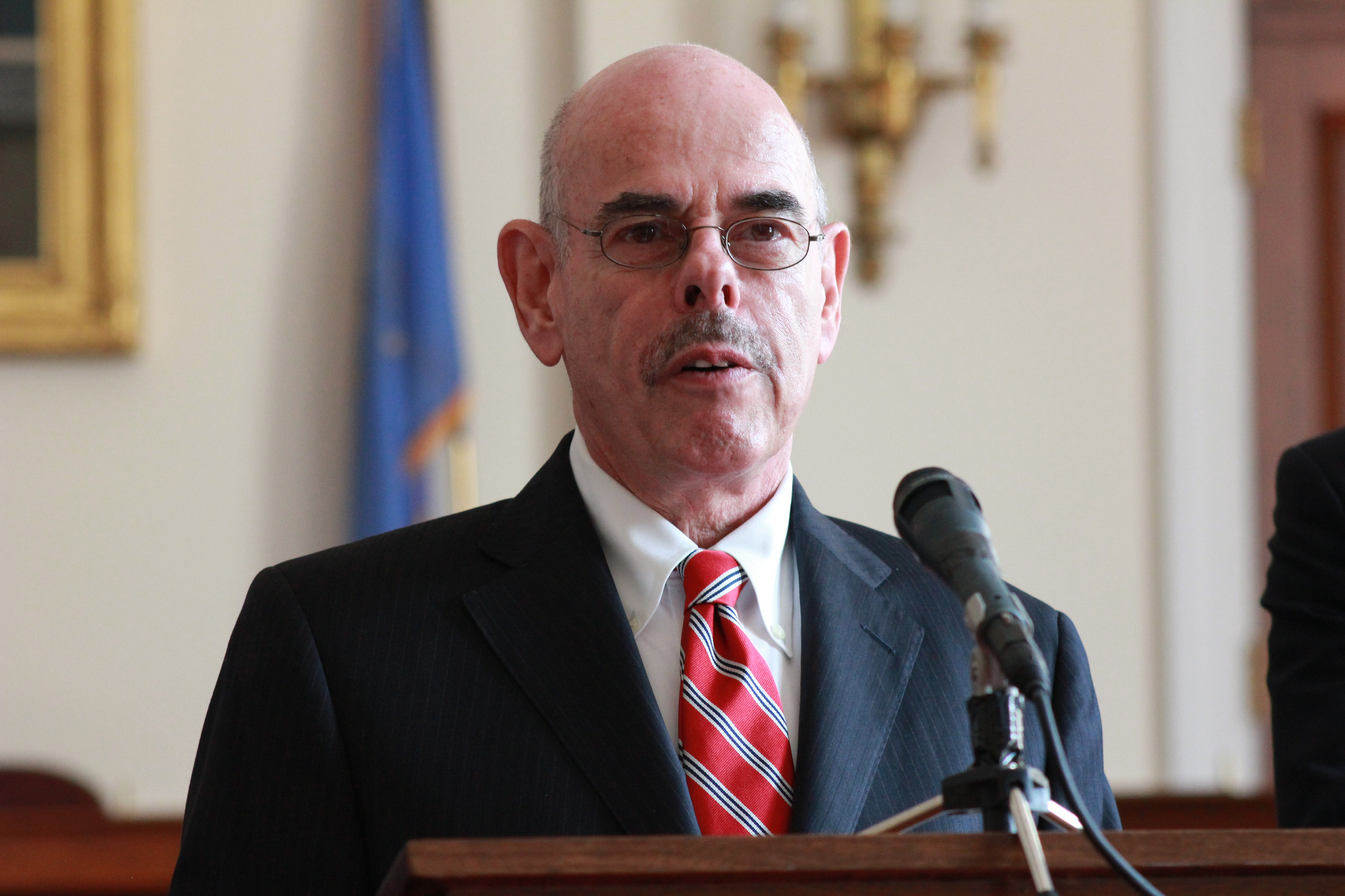
Talk Radio News ServiceHenry Waxman is trying a new approach with his latest climate bill.
One of the common criticisms of the cap-and-trade effort — well-captured in sociologist Theda Skocpol’s after-battle report [PDF] — is that the legislation was crafted almost entirely behind closed doors, first between green groups and corporations in the USCAP coalition, then between horse-trading members of Congress.
Rep. Henry Waxman (D-Calif.) has heard this criticism and acted on it.
Waxman, cosponsor of the climate bill that passed the House in 2009, is one of the great unsung heroes of the climate fight. He’s the liberal legislator’s liberal legislator: He works for the public good but cares about results above all and will pursue them with insane persistence, for years on end. He draws little attention to himself — you’ll never see him on the Sunday talk shows — but his work inside Congress is unceasing. Ever since the failure of the last climate bill, he’s been pushing for hearings, issuing letters and reports, and generally agitating the (now Republican-controlled) Energy and Commerce Committee to take climate change seriously.
Now Waxman and a few colleagues — Rep. Earl Blumenauer (D-Ore.), Sen. Brian Schatz (D-Hawaii), and Sen. Sheldon Whitehouse (D-R.I.) — have kicked off a process that looks very different from the USCAP one. They have put a discussion draft of a climate bill online and are seeking public and expert input.
Here’s what the bill does:
• Establish a carbon pollution fee that applies to all six categories of greenhouse gases.
• Require large carbon pollution sources to pay the fee for carbon pollution permits based on the quantities of carbon pollution reported by the sources under the EPA’s Greenhouse Gas Reporting Rule.
• Create a program to be jointly administered by the Department of the Treasury and EPA. EPA would implement and enforce emissions reporting under EPA’s Greenhouse Gas Reporting Rule, and Treasury would assess, collect, and enforce the fee requirements at the point where carbon pollution is emitted or passed on to consumers, depending on the type of source.
Here are the four questions upon which the legislators are seeking particular guidance:
1. What is the appropriate price per ton for polluters to pay? The draft contains alternative prices of $15, $25, and $35 per ton for discussion purposes.
2. How much should the price per ton increase on an annual basis? The draft contains a range of increases from 2% to 8% per year for discussion purposes.
3. What are the best ways to return the revenue to the American people? The discussion draft proposes putting the revenue toward the following goals, and solicits comments on how to best accomplish each: (1) mitigating energy costs for consumers, especially low-income consumers; (2) reducing the Federal deficit; (3) protecting jobs of workers at trade-vulnerable, energy intensive industries; (4) reducing the tax liability for individuals and businesses; and (5) investing in other activities to reduce carbon pollution and its effects.
4. How should the carbon fee program interact with state programs that address carbon pollution?
(If you have opinions on these matters, you can send them to cutcarbon@mail.house.gov until April 12.)
A few thoughts on these four questions:
1. The price on carbon should theoretically be based on the “social cost of carbon,” i.e., the cost to society of a ton of carbon emissions. In 2010, the Obama administration settled on a figure for the social cost of carbon: $21. That’s why lots of carbon-pricing proposals start around there (the recent Sanders-Boxer bill starts at $20 a ton; the Brookings Institution carbon-tax proposal starts at $16).
Obviously there’s no way to specify the social cost of carbon with scientific precision; there are value judgments involved. But recent research indicates that the government figure is woefully low. See this paper from Frank Ackerman and Elizabeth A. Stanton, or Ackerman’s accessible introduction to the concept. See also this paper from Laurie Johnson and Chris Hope, which Johnson discusses here and I discuss here.
The Johnson/Hope paper puts the present social cost of carbon between $55 and $266 per ton. Ackerman doesn’t try to pin down a number, but notes:
In the United Kingdom, where carbon pricing and cost calculations have a longer, better-researched history, the latest estimate is a range of $41 to $124 per ton of CO2, with a central case of $83.
Suffice to say, an $83/ton carbon tax is a lot higher than a $20/ton one, and probably closer to the true value of carbon.
But $35, the highest end of Waxman’s range, is considerably more ambitious than most carbon-pricing proposals to date and probably the outer bound of today’s Overton window. Climate hawks should, needless to say, support the highest carbon price possible. (The chances of the U.S. political system inadvertently overpricing carbon are, to my mind, somewhere between 0 and 0.001 percent.)
2. This is an interesting question and I don’t have any settled thoughts on it. The Brookings carbon tax would rise at 4 percent above inflation each year until 2050. (In a post today, Brad Plumer says that wouldn’t be enough.) The Boxer-Sanders carbon tax would rise at 5.6 percent a year for 10 years.
I’d be interested to hear if anyone’s seen research or academic work on this. It feels a bit arbitrary, like a number plucked from the ether. Obviously I’m inclined to say “as high as possible,” or at least, “high enough to get the job done,” but I don’t know if there are arguments to be had about indexing it to inflation in some way or otherwise tying it to a real-world number.
3. This is a hugely important question and gets too little attention. To me, the mark of a crappy carbon-pricing proposal is that it botches the revenue side.
One of the biggest mistakes climate hawks have made in the last few years is accepting that “revenue neutrality” is a desirable feature of a carbon price. It’s based on the premise that government spending is inherently suspect, illegitimate, a matter of “pork” and “pet projects” and “picking winners.” In other words, it’s based on a deeply conservative premise.
Perhaps it’s necessary to attract conservative support for the proposal? Well, maybe it will be necessary some day, but as things stand, conservatives are absolutely, ideologically opposed to new taxes, including carbon taxes, whether or not they are revenue-neutral. So why make a huge concession before there’s any reason to believe it will gain anything? Preemptive concessions are a longstanding Democratic tradition, I realize, but I don’t see that as something climate hawks should emulate.
And if it is a necessary political concession, that’s fine, but let’s remember it’s a concession. It’s not a desiderata in its own right. Government spending is an absolutely necessary part of a transition to sustainable energy. Why forego a large source of revenue? (The economist’s answer is that reducing other tax burdens is the only way to mitigate the economic impact of a tax, which I don’t entirely agree with, but it’s too much to get into here.)
Anyway, Brookings proposes to set 15 percent of the revenue aside for low-income households (which is good) and use the rest to reduce the corporate tax rate and the federal deficit. What a waste!
The Sanders-Boxer bill devotes 80 percent of the revenue to per-capita dividends and the remainder to a mix of deficit reduction (feh) and clean-energy support.
In my ideal bill, the ratio would be roughly reversed. Around 15 percent of the revenue would go to compensating low-income taxpayers. Around 10 percent or so would go to bribery — that is, subsidies to various carbon-intensive and trade-exposed industries to help protect them from the impact of a tax. And the other 75 percent would go to reducing carbon, i.e., to clean-energy research, development, and deployment. (The public health benefits alone would pay for this, especially if investments are considered over their total lifetime and a low or zero discount rate is used, but again, that’s too much to get into here.)
Unfortunately, Waxman and co. seem to have taken “revenue neutrality” as a core principle and, in revenue terms, view carbon-reduction spending as an afterthought. I think it’s a fateful mistake, policy-wise, but it appears I’m going to have to live with it. If the liberal caucus won’t put forward a liberal bill, who will?
4. This is a sticky wicket, but honestly, since this bill doesn’t have a chance in hell of passing, digging into the technical details would just bore everyone. So let’s skip this.
Aside from the mechanics of the bill, I have to wonder: What exactly is the strategy here? In the last few weeks, we’ve had Bernie Sanders (I-Vt.) and Barbara Boxer (D-Calif.) (probably the two most liberal senators) and a group of liberal Dems led by Waxman release two not-quite-overlapping carbon-pricing proposals. Obviously these proposals have no real chance of passing, though they’ll serve as message bills. But what’s the message? From what I hear, neither was telegraphed very far in advance. No work was done to build coalitions to push or publicize them. In terms of optics, they seem only to reinforce the D.C. conventional wisdom that carbon pricing is a doomed and futile preoccupation of left liberals.
I’m having trouble avoiding the the conclusion that, after the cap-and-trade push fell apart, the climate-hawk coalition fragmented and everyone is off doing their own thing, throwing stuff at the wall to see what sticks. Maybe that’s the right way to go. But I’d feel more comfortable if I could discern some method to the madness.



